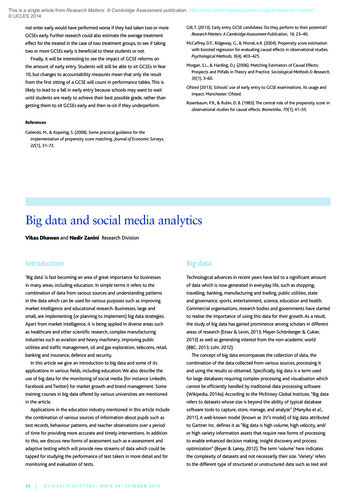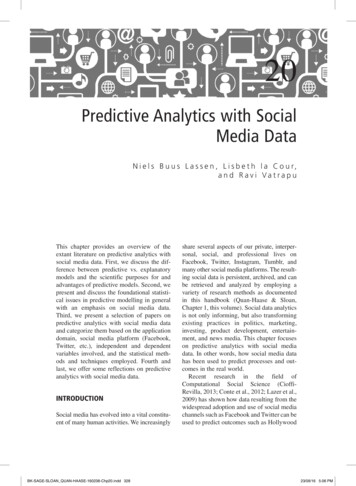
Transcription
This is a single article from Research Matters: A Cambridge Assessment publication. ters/ UCLES 2014not enter early would have performed worse if they had taken two or moreGCSEs early. Further research could also estimate the average treatmenteffect for the treated in the case of two treatment groups, to see if takingtwo or more GCSEs early is beneficial to these students or not.Finally, it will be interesting to see the impact of GCSE reforms onthe amount of early entry. Students will still be able to sit GCSEs in Year10, but changes to accountability measures mean that only the resultfrom the first sitting of a GCSE will count in performance tables. This islikely to lead to a fall in early entry because schools may want to waituntil students are ready to achieve their best possible grade, rather thangetting them to sit GCSEs early and then re-sit if they underperform.Gill, T. (2013). Early entry GCSE candidates: Do they perform to their potential?Research Matters: A Cambridge Assessment Publication, 16, 23–40.McCaffrey, D.F., Ridgeway, G., & Morral, A.R. (2004). Propensity score estimationwith boosted regression for evaluating causal effects in observational studies.Psychological Methods, 9(4), 403–425.Morgan, S.L., & Harding, D.J. (2006). Matching Estimators of Causal Effects:Prospects and Pitfalls in Theory and Practice. Sociological Methods & Research,35(1), 3–60.Ofsted (2013). Schools’ use of early entry to GCSE examinations. Its usage andimpact. Manchester: Ofsted.Rosenbaum, P.R., & Rubin, D. B. (1983). The central role of the propensity score inobservational studies for causal effects. Biometrika, 70(1), 41–55.ReferencesCaliendo, M., & Kopeinig, S. (2008). Some practical guidance for theimplementation of propensity score matching. Journal of Economic Surveys,22(1), 31–72.Big data and social media analyticsVikas Dhawan and Nadir Zanini Research DivisionIntroductionBig data‘Big data’ is fast becoming an area of great importance for businessesTechnological advances in recent years have led to a significant amountin many areas, including education. In simple terms it refers to theof data which is now generated in everyday life, such as shopping,combination of data from various sources and understanding patternstravelling, banking, manufacturing and trading, public utilities, statein the data which can be used for various purposes such as improvingand governance, sports, entertainment, science, education and health.market intelligence and educational research. Businesses, large andCommercial organisations, research bodies and governments have startedsmall, are implementing (or planning to implement) big data strategies.to realise the importance of using this data for their growth. As a result,Apart from market intelligence, it is being applied in diverse areas suchthe study of big data has gained prominence among scholars in differentas healthcare and other scientific research, complex manufacturingareas of research (Einav & Levin, 2013; Mayer-Schönberger & Cukier,industries such as aviation and heavy machinery, improving public2013) as well as generating interest from the non-academic worldutilities and traffic management, oil and gas exploration, telecoms, retail,(BBC, 2013; Lohr, 2012).banking and insurance, defence and security.The concept of big data encompasses the collection of data, theIn this article we give an introduction to big data and some of itscombination of the data collected from various sources, processing itapplications in various fields, including education. We also describe theand using the results so obtained. Specifically, big data is a term useduse of big data for the monitoring of social media (for instance LinkedIn,for large databases requiring complex processing and visualisation whichFacebook and Twitter) for market growth and brand management. Somecannot be efficiently handled by traditional data processing softwaretraining courses in big data offered by various universities are mentioned(Wikipedia, 2014a). According to the McKinsey Global Institute, “Big datain the article.refers to datasets whose size is beyond the ability of typical databaseApplications in the education industry mentioned in this article includesoftware tools to capture, store, manage, and analyze” (Manyika et al.,the combination of various sources of information about pupils such as2011). A well-known model (known as 3V’s model) of big data attributedtest records, behaviour patterns, and teacher observations over a periodto Gartner Inc. defines it as “Big data is high volume, high velocity, and/of time for providing more accurate and timely interventions. In additionor high variety information assets that require new forms of processingto this, we discuss new forms of assessment such as e-assessment andto enable enhanced decision making, insight discovery and processadaptive testing which will provide new streams of data which could beoptimization” (Beyer & Laney, 2012). The term ‘volume’ here indicatestapped for studying the performance of test takers in more detail and forthe complexity of datasets and not necessarily their size. ‘Variety’ refersmonitoring and evaluation of tests.to the different type of structured or unstructured data such as text and36 R E S E A R C H m atters : i ssue 1 8 / summe r 2 014
numeric, video and audio and log files. ‘Velocity’ refers to the speed withThis gives an idea of how much traffic is likely to flow throughwhich data can be made available for analysis. Sometimes other V’s suchthe internet in the coming years, and the investment being made byas ‘Veracity’ (aiming at data integrity and the ability of the organisationgovernments (and private organisations) realising the potential impact ofto confidently use the data) or ‘Value’ (does new data enable anthis data revolution (Wikipedia, 2014a).organisation to get more value?) are highlighted as well (Swoyer, 2012;Villanova University, 2014).According to CompTia (The Computing Technology IndustryAssociation), in 2013, 28% of UK companies were using big data, 36%The rising potential of big data has led to the funding of several newwere planning a big data initiative that year and 95% see data as crucialinitiatives by governments in recent years. The European Union hasto success over the next two years (Raconteur Media, 2013). They alsorecently launched the Big Data Public Private Forum (called the BIGreport that there was a 5% annual global growth in IT spending in 2013Project) to engage with academics, companies and other stakeholderscompared to a 40% growth in data. There has been a phenomenalto formulate a clear strategy for research and innovation in big data.explosion of data available from online usage in recent years. AccordingThe outcomes of the project will be used as input for Horizon2020 –to some estimates (IBM, 2013):an initiative aimed at securing Europe’s global competitivenessl1.43 billion people worldwide visited a social networking site in 2012;lnearly one in eight people worldwide have their own Facebook page;lone million new accounts were added to Twitter every day in 2012;which aims to gain insights from large and complex collections of datalthree million new blogs come online every month;in the fields of science and engineering, national security and teachingl65% of social media users say they use it to learn more aboutand creating new growth and jobs in Europe (BIG, 2014; EuropeanCommission, 2014). The US Government announced funding of 200million for the “Big Data Research and Development Initiative” in 2012and learning (Kalil, 2012). The United States National Security agencybrands, products and services.is constructing a data centre in Utah to handle information theycollect over the internet. There may be some concerns over privacyThe amount of data collected in organisations is expected to growrelated to this development because it might result in the collectionin the coming years. This could be due to an increase in the efficiencyof personal data of individuals, such as internet access history, privateand declining cost of data storage and processing capabilities, thecommunications, credit card usage and health records, etc.spread of digital technologies, and volume of data available from internetThe amount of data which is expected to be processed (not stored) atand digital devices and sophistication of algorithms for processing.the facility in Utah is likely to be in ‘yottabytes’ – the largest unit prefix inA significant amount of this data would be generated online which wouldthe International System of Units (SI) and which was added in 1991. Onerequire substantial investment in data storage facilities. It has beenyottabyte (prefixed as YB) is equivalent to 1024 bytes. Table 1 gives the datarecently reported that Facebook is currently building a data centre instorage units in use. Gigabyte is still the most commonly used measure forSweden the size of 11 football fields, along with two others in America,the capacity of hard disk, however terabyte and petabyte have started toto collect and process their data (Bradbury, 2013).be used as well. Today a 1-terabyte disk drive (about 2.5 inches wide) canThere is a considerable amount of interest in educational organisationsfit within a laptop. It is fascinating to note that, according to one estimate,in exploiting the applications of big data and analytics, which is expectedstoring a yottabyte on terabyte sized drives would require a million cityto rise in the near future. However, in order to make the most of big data,block size data-centres, as big as the US states of Delaware and Rhodeorganisations should be clear about what exactly they want to investigateIsland (Wikipedia 2014c; 2014d; Diaz, 2010).and how they plan to use the information. We believe that businessesneed to consider the following questions while implementing big data/social media policies:1. Are we future ready?Table 1: Data storage units (Wikipedia, 2014d).2 Is it hype or necessity?Metric prefixes (multiples of bytes)3. Are there any simpler and/or more economical ways of gettingsimilar 024KB10002MB megabyte10242MB MegabyteMiB mebibyte10003GB gigabyte10243GB GigabyteGiB gibibyte10004TB terabyte10244TBTiB tebibyte10005PB petabyte10245PiB pepibyte10006EB10246EiB exbibyte10. Are we also using traditional sources of information (such as10007ZB zettabyte10247ZiB zebibyteinterviews and focus groups) to complement online metrics?10008YB yottabyte10248YiB yobibyteKilobyteKilobyteTerabyteKiB kikibyte4. Is it better to develop in-house capability or hire external resource?5. Would our customers/stakeholders be comfortable with suchmonitoring?6. Do we need to disseminate our policy to the stakeholders? If yes,have we done that?7. What is the state of preparedness of our competitors?8. Are we adhering to the data privacy laws?Exabyte1. Joint Electron Device Engineering Council memory standards2. International Electrotechnical Commission units9 How much value can be placed on the online behaviour of people?11. Are we also relying on human judgement for interpreting the data(and not only on software-generated results)?12. Are we working with other departments within the organisation todevelop a comprehensive policy?R ESEAR C H mat t ers : issue 18 / summer 2014 37
Applications of big data(www.behaviouralinsights.co.uk) which is jointly owned by the UKThere are many examples of how big data is being used in various fields.Government and Nesta www.nesta.org.uk. This organisation bringsWhilst these are not directly associated with the field of education, theytogether data from a range of inter-related academic disciplinesgive us a picture of the impact of data in our day-to-day lives (Raconteur(Behavioural Economics, Psychology, and Social Anthropology) tomedia, 2013). Examples include:understand how individuals make decisions in practice and how they arelIBM’s Deep Thunder weather analytics package: helps farmersknow when to irrigate their crops;lSAS: uses big data to identify fraud in the insurance sector;lBritish Airways’ Know Me Programme: uses the data collected toget a better insight into personal preferences and buying patterns ofits frequent fliers;lTransport for Greater Manchester: uses real-time trafficinformation to avoid congestion on roads;llikely to respond to options so as to enable the Government to design itspolicies or interventions accordingly.Applications of big data in educationA large amount of data is being generated in schools and highereducation. Big data in education could be used to:lunderstand performance and behaviour patterns of students;lkeep track of student progress throughout their education, allowingtimely intervention if any anomalies are noticed;Bank of America Merrill Lynch: creates practical and effectivesolutions for clients based on a more comprehensive and holisticleach student in order to provide remedial help without stigmatisingunderstanding of their requirements;lor isolating students or embarrassing them in front of their peers;East Kent Hospitals University NHS Foundation Trust: staff givenaccess to data to adapt to real-time changes such as re-allocationllllbehaviour;lfeedback in real-time to help improve student performance;Public Health England: creates highly targeted treatments accordinglconduct adaptive testing;to how patients respond in real-time through recently announcedlmerge systems such as learning management and curriculumrecords and 350,000 new entries added every year);initiatives such as bring your own device (BYOD);llllcombine various data sources such as course records, studentRoyal Dutch Shell: spends 650 million a year compiling big dataattendance, class rosters, programme participation, degreeacross a number of sites so that they can more accurately predictattainment, discipline records and test scores whic
Association), in 2013, 28% of UK companies were using big data, 36% were planning a big data initiative that year and 95% see data as crucial to success over the next two years (Raconteur Media, 2013). They also report that there was a 5% annual global growth in IT spending in 2013 compared to a 40% growth in data. There has been a phenomenal











